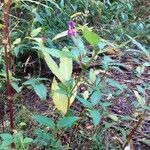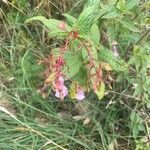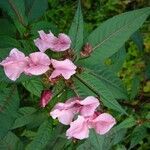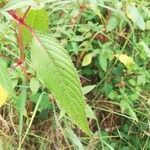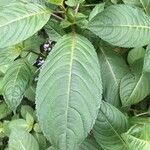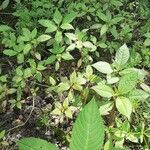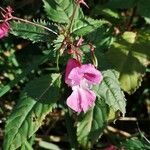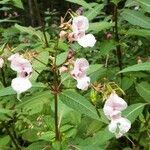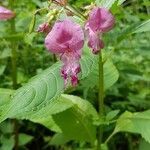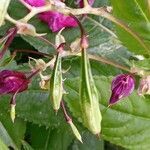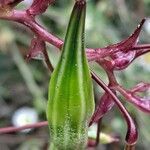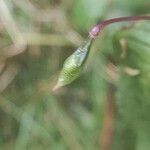Annual, glabrous herb; stems erect, single but branched above, to c. 2.5 m high, succulent, ribbed, swollen at nodes. Petioles to c. 8 cm long, pink above, narrowly winged, with scattered purplish elongated glands in distal 1/2. Lvs opposite or in whorls of c. 3. Lamina 10-20 × 3-8 cm, lanceolate to ovate, sharply serrate; veins impressed above, raised below; base cuneate or attenuate; apex acuminate. Fls in diffuse cymes in upper lf axils of branches, shining. Bracts and lateral sepals 5-10 mm long, ovate, pink, acuminate. Posterior sepal forming large backwards projecting hood 2.2-3 cm long (excluding spur), pink or rose with dark spots inside; spur 5-7 mm long, rather stout, green. Corolla 2-lipped, white or pale pink; uppermost petal 1.5-2 cm long, subreniform; apex truncate to slightly emarginate; lateral petals very asymmetric, c. 3.5 cm long when stretched out, sharply bent in middle with lower halves forming a circular orifice enclosing the elongated anther mass. Anthers yellow. Capsule 2-3 cm long, usually purplish on exposed side, constricted in upper 1/2, with 5 acute ridges. Seed 3.5-5 mm long, ± broadly ovoid, shining black, with a single ridge down 1 side; base truncate; apex slightly beaked.
More
Coarse, erect annual to 2 m; stems hexagonal; lvs mostly or all whorled or opposite, lanceolate to lance-ovate, acuminate, sharply serrate; racemes ascending on long peduncles, few-fld; fls purple or blue, varying to white, 3 cm; 2n=18, 20. Native of the Himalayan region, becoming established as an escape from cult. in the ne. part of our range. Summer. (I. roylei)
An annual herb. It grows 3 m tall. The flowers hang by a thin stem. They have a distinctively pointed pink hood at the rear.
Shrubberies and bushy places, often on grazing ground, frequently gregarious, 1800-4000 metres in the Himalayas. Grows on river banks and waste places in Britain.
More
It is a temperate plant. It grows in wetlands, along streams and in moist forests. In Pakistan it grows between 1,600-4,300 m altitude.
